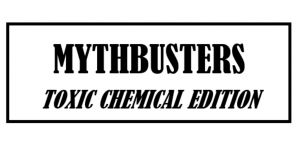
PART 1: Busting industry-perpetrated myths about new chemicals and worker protection under TSCA
Richard Denison, Ph.D., is a Lead Senior Scientist.
This week the House Energy & Commerce Committee held a hearing on EPA’s failures to protect workers from chemical risks. It featured a number of compelling testimonies from worker representatives: auto workers, firefighters, teachers, and farmworkers. It also featured testimony from a former Occupational Safety and Health Administration (OSHA) official, who made the case for why it is so critical that the Environmental Protection Agency (EPA) comply with the mandates and use the enhanced authorities Congress gave the agency under the Toxic Substances Control Act (TSCA) to protect workers exposed to chemicals. He detailed why OSHA is unable to do so, describing OSHA as “outmatched” and having “exhausted its capacity” in the face of decades of severe budget cuts and limited legal authority.[pullquote]The chemical industry is perpetuating damaging myths about worker protection at EPA and OSHA, which have unfortunately taken a firm hold in the Trump EPA.[/pullquote]
Unfortunately, the hearing also included testimonies from two chemical industry representatives who painted a highly deceptive picture of what EPA has done to protect workers under the new TSCA and the adequacy of OSHA regulations regarding chemical risks in the workplace and the extent of compliance with them. This and future posts will address the damaging myths these witnesses are perpetuating, which have unfortunately taken a firm hold in the Trump EPA.
Myth #1: EPA is committed to protecting workers when reviewing new chemicals under TSCA.
One of the industry witnesses was Beveridge & Diamond’s Mark Duvall, currently a primary outside counsel to the chemical industry’s main trade association, the American Chemistry Council (ACC), and before that a longtime Dow Chemical attorney. In his testimony, Duvall asserted EPA is thoroughly protecting workers when reviewing new chemicals. As support, he presented a wholly misleading set of statistics on how many of EPA’s decisions on new chemicals have included worker protections since the 2016 amendments to TSCA. Based on this, he concluded that “almost 4 out every 5 PMN [premanufacture notification] substances that receive a final determination are regulated.”
Manipulating statistics on EPA new chemical decisions: What Duvall failed entirely to mention, however, is that his statistics lump together decisions on new chemicals EPA made during the first period after passage of the new TSCA – when it was largely complying with the new law’s legal requirements – and the more recent decisions it has made under new, still not public, policies that made radical changes in the agency’s approach to reviewing new chemicals. Decisions under the new approaches began to issue in late July 2018; we blogged extensively at the time about the first of these.
We have tracked each decision EPA has made since late July 2018, and in a recent blog post we noted how many of these decisions are throwing workers under the bus, allowing unfettered market access to chemicals even where EPA has identified serious potential risks to workers. As explained in our earlier blog post, EPA relied on ineffective, nonbinding documents to “expect” those risks out of existence.
Here is the breakdown of EPA’s decisions since the dramatic shift in its policies: Of the 75 premanufacture notifications (PMNs) on which EPA has made final determinations using the new policies since late July 2018, 62 of them have asserted that the new chemical is “not likely to present an unreasonable risk.” That means that over the last seven and a half months EPA has green-lighted without regulation 83% of the new chemicals subject to its new policies – a complete reversal from what Duvall claimed in his testimony.
Duvall’s omission of any mention of this critical distinction and wholesale reversal by EPA drastically misrepresented the current situation and borders on the dishonest.
Masking his and his clients’ relentless push for EPA to rely on purely voluntary workplace protections: Duvall’s effort to blur the distinction I just described is both ironic and the height of hypocrisy. First, Duvall knows full well that EPA reversed course because of relentless chemical industry pressure demanding that EPA stop regulating so many new chemicals under TSCA. Yet now he seeks to laud and take credit for EPA’s initial, relatively heavy regulation of new chemicals in order to assert that the Trump EPA is committed to and is protecting workers.
Touting EPA’s past imposition of mandatory workplace controls he and his clients oppose: Second, Duvall’s testimony provides statistics on how often EPA has imposed worker protection requirements for various categories of EPA decisions. For example, he says that most consent orders EPA has issued include “worker protection requirements.” He also discusses EPA’s use of significant new use rules (SNURs) to extend the reach of those consent orders, noting (emphases added):
Over the years, EPA has adopted 463 final SNURs that incorporate by reference worker protection provisions listed in 40 C.F.R. § 721.63, such as particular kinds of respirators, gloves, and protective clothing. In these SNURs, EPA has supplemented applicable OSHA requirements to mandate particular kinds of respirators and protective clothing. In some cases, it has set exposure limits and related monitoring requirements if companies can establish that exposure levels are low enough that respirators are not necessary.
EPA has adopted 404 final SNURs that incorporate by reference hazard communication requirements listed in 40 C.F.R. § 721.72. In these SNURs, EPA has gone beyond OSHA’s general hazard communication standard to mandate identification of particular hazards and protective measures.
So, let’s get this straight. Duvall cites these statistics to demonstrate how often EPA has imposed workplace protections through consent orders and SNURs – the very instruments EPA has all but stopped issuing under its new policies. He fails to acknowledge that both were largely abandoned in direct response to the chemical industry’s loud complaints to EPA that it doesn’t like consent orders and SNURs. Duvall himself co-authored comments submitted to EPA by ACC conveying those complaints.
He then glosses over the fact that it is only through the use of such instruments that EPA can impose binding requirements for companies to employ worker protection and hazard communication measures or, in the case of SNURs, to require notification to EPA of any intent to depart from them. If EPA only issues a “not likely” finding – as it is now routinely doing – any such measures are purely voluntary.
The regulatory provisions Duvall cites in the excerpt above are incorporated into EPA’s general SNUR regulations, so that EPA need only cross-reference them when issuing a SNUR. Adding to the irony of his citing these regulations, Duvall notes (see the emphases in the excerpt above) that these provisions go beyond OSHA requirements. Yet he, his industry clients, and others in the industry are not only calling on EPA to abandon these binding instruments, but also to defer to OSHA requirements or to instead rely on Safety Data Sheets – documents called for by OSHA regulations but that do not impose any binding requirements on employers to actually protect their workers.
It should be noted that in a handful of recent cases where EPA issued a “not likely to present an unreasonable risk” determination, EPA also proposed a SNUR for the same substance. However, in a striking departure from most of the SNURs EPA has issued in the past, these new proposed SNURs do not incorporate the worker protection and hazard communication requirements that Duvall cites to support his contention that EPA adequately protects workers. In other words, not only did these chemicals get unfettered market access because of their “not likely” determinations, in issuing proposed SNURs for these chemicals EPA opted not to impose any of the binding requirements for “protection in the workplace” or “hazard communication” available to it in its general SNUR regulations.
In my next post, I’ll delve into a second industry-perpetrated myth espoused by both Duvall and the other industry witness at this week’s hearing: That OSHA regulations already provide ample protection to workers from chemical risks.











